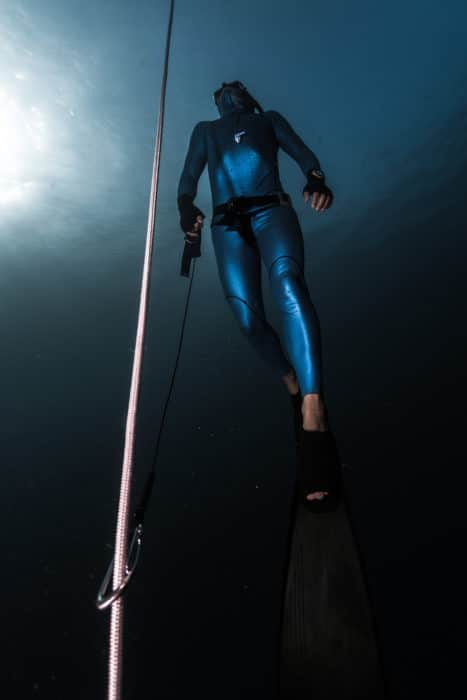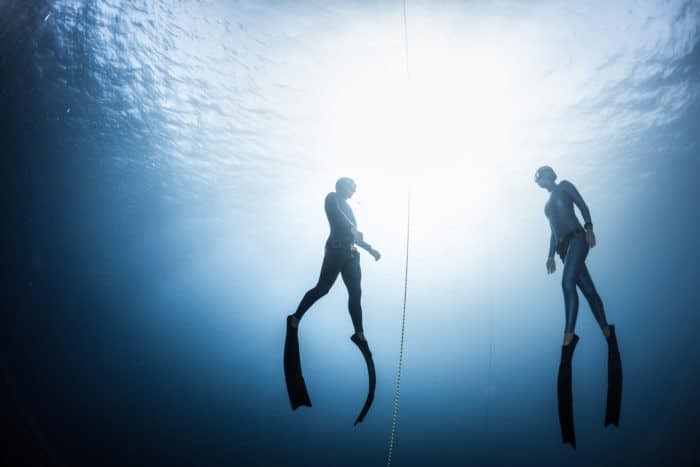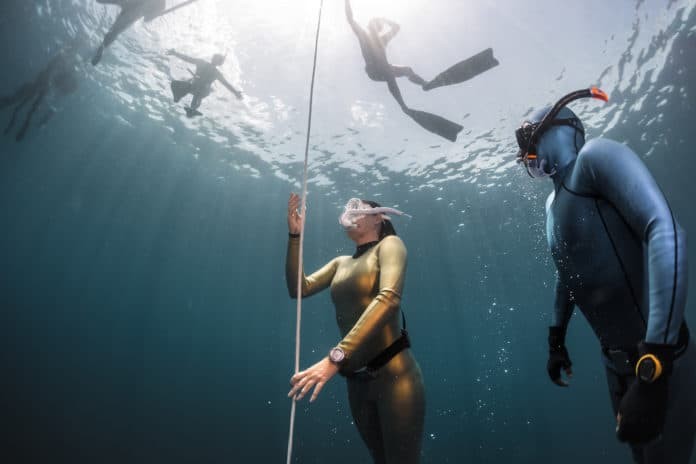Discussions about freediving safety in competitions are always evolving, but what about safety in on our own training sessions? We may not be going to the same depths as top freediving athletes, but deep and shallow water blackouts are a possibility for us as well. That is why safety is and should always be the number one concern for freedivers, but is often not taken seriously enough, especially at beginner levels. So how can we, as freedivers, keep our training sessions as safe as possible?
Ask For Safety
Whether you are feeling a little shy about needing safety for a certain depth, or overconfident and wanting to show off, please avoid refusing safety, and make sure to ask for it if you are not already offered it. Not everyone finds it necessary to have a safety diving down for you during a warm-up when the line is at 10 or 15m (32 to 49ft), but if you are going deeper than that, it is always safer if someone is meeting you at least at 10m (32ft), especially for beginners. This is especially important in the case of a shallow water blackout, which occurs due to the drastic drop in oxygen partial pressure in the lungs between 10m (32ft) and the surface.
This can also apply to advanced freedivers performing FRC (Functional Residual Capacity or “half-lung”) and RV (Residual Volume or “empty-lung”) dives. First of all, FRC and RV dives should only be performed by advanced divers, if performed at all. Second of all, if these dives are being performed, sometimes the freedivers think that they do not need safety since the dives are a lot shallower than their full-lung dives. This is a mistake; there is a much higher risk of squeezing, even at these “shallow” depths, due to the reduced air volume in the lungs. Ask for and provide safety for these types of dives, no matter the depth.
Always Wear a Lanyard

We love freediving lanyards so much, we wrote a whole article about them. But to summarize, lanyards are an essential piece of equipment for freedivers training depth, not to mention required when entering a competition. They keep you close to the dive line if there is a strong current, keep you attached to the line if a blackout occurs, and if you blackout too deep for your safety to rescue you, they can pull up the dive line with you attached, until you reach rescuable depth. Some certification courses recommend that lanyards should be worn in less than 10m (32ft) of visibility or in a strong current, but you can never go wrong wearing one all of the time, especially if you are diving with a nose-clip.
If You Feel Uncomfortable, Refuse To Safety
If you are training with freedivers who dive much deeper than you, it can be daunting to provide safety. For example, your PB (personal best) might be 25m (82ft), but someone diving to 60m (196ft) wants safety at 20m (65ft). It will already feel challenging enough just having to reach that depth, not to mention hanging there until the freediver meets you on the ascent. In this case, you should absolutely feel comfortable enough to let your partner know that you cannot confidently safety them. This should not feel embarrassing, as we all remember what it is like in the beginning stages of our freediving careers. No one is judging you, and even better, they will be thankful that you spoke up about being uncertain of your abilities rather than risk providing unreliable safety.
Safety Is a Team Effort
When you are diving with more than one other person on the buoy, make use of it; safety does not have to only be up to one other person. While you are all briefing before the session, verify that while the safety person dives, the third person is holding onto the rope and looking along the rope for any signals. If there is trouble, the safety can either signal with their arms or by shaking the rope, furthermore signaling the third person to either dive down and assist, or get on the buoy and start pulling up the line if the diver is deep. Organize signals and procedures beforehand, and train different scenarios. These competition safety procedures do not have to be just for competitions; make use of them in your own training sessions.
Also, if you start diving with a new buddy, verify that they have taken a certified freediving course and/or know how to properly rescue a freediver. Better yet, practice rescuing each other so that you have the utmost confidence in your buddy. Act out different scenarios in different conditions so that you are prepared for anything that could happen.
Never Freedive Alone

As much as it is discussed in the freediving community, there are still people who choose to freedive alone. Not even just diving recreationally along a reef, but training alone, whether in a pool or on a line. If you follow freediving news at all, you are aware that experienced, professional athletes have died training alone, and sadly it is not as uncommon as you may think. Blackouts themselves are not fatal, so long as there is someone there to bring you to the surface and turn you over. But if there is no one there to turn you over, who will save you? That is why the most important rule in freediving is to never freedive alone.
Improve Your Own Safety Skills
A good safety diver allows the primary freediver to feel much more relaxed and at ease, and focus on what needs to be focused on, rather than worrying about the safety’s capabilities. This is why it is vitally important to be the best safety diver possible: focus on the person diving, learn timing, take your safety dive as seriously as you take your own dive, hold the rope as the primary freediver descends, take a CPR/First Aid course, etc. The more seriously you take safety in freediving, the more respect you will earn from other freedivers, and you will never have a shortage of people wanting to train with you.
Final Thoughts
The concept of safety can be severely underestimated, especially in the case of people who have not taken a certified freediving course and are not aware of what exactly can go wrong. But in the end, it is always better to have proper safety and end up not needing it because the dive was successful, rather than gambling your life on performances in unsafe conditions.

